Generating things
with code
Procedural Content Generation (PCG)
programmatic generation of content
often using pseudo-random data
designing a process rather than an object
PCG are massively used in design,
games, art, vfx, architecture...
important
- data
- space
- process
not important
- coding platform & language
- coding tools & toolchain
- capture device & data sources
what PCGs are good at
modelization
create the model of a system
simulation
use the model to process data
exploration
change the model's parameter
corollary: visualisation
rendering the model: 2D, 3D graphics,
video, tangible objects, installation...
pcg upsides
- the computer does the boring part
- few paramaters give many variations
- very good at serial content
- emergent behaviours can produce
surprising or unexpected results
pcg downsides
- mathematical uniqueness is often not
enough to create significant differences - hard to maintain consistent variations
while using numerous variables - hard to assess "good" settings
human curation required
model: universe generator
simulation: update the model with game logic
exploration: move & interact with the model
visualisation: rendering a 3D scene
nervous systems - KINEMATICS FOLD
model: triangle based patch modeler
simulation: apply physics rules to the model
exploration: change the base model
visualisation: 3D renders & 3D print
We Are Chopchop - unnamed soundsculpture
system: use particles to represent a 3D object
simulation: playback of a recorded sequence
exploration: move a virtual camera through space
visualisation: render particles in 3D
system rules:
- spawn a particle at a 3D location
- make the particle fall & disappear
the particles move & disappear procedurally
this system can work for any 4D data set
1. DATA
N dimensions
continuous VS discrete
the world is a continuous system
computers process discrete data
discretizing the world
continuous data are measureddiscrete data are counted
continuous => discrete
time => intervallight => color palette
reaction => process
phenomenon => simulation
N-dimensional objects
a variable number of dimensions
the values of each dimension of an object
can vary without affecting the others
light's dimensions
direction, speed, wavelength, energy
computer representation
of a unidimensional datum
the BIT
0 / 1
limitation: it can only describe whether a
given property of the object "is" or "isn't"
1D extension pack
- bit (0/1)
- byte / octet: 8 bits & 256 integer values
- int, float, uint, double: 8, 16, 32, 64 bits
- single character: 7 bits (US ASCII ), 32 bit (UTF-32)
or a character is stored as an array of bits

so, technically, a number is itself
a N-dimensional object
2 dimensional data
series of unidimesnsional data- typed linear array: ["a", "b", "c"] / [ 0, 1, 2 ]
- string : "Nicolas Barradeau"
- an empty image: [ width * height ]
N-dimensional data
combinatorics of unidimensional data- color: { R, G, B }
- a vector: { X, Y, Z }
- binary pixel: { X, Y, value }
- pixel, color: { X, Y, R, G, B }
- pixel, color & alpha: { X, Y, R, G, B, A }
- stereo sound: { left, right, time, sampling rate }
- video: pixel, color, sound, time
- 3D object: XYZ, indices, normals, colors, uvs...
?-DIMENSIONS
how many dimensions to a TWEET? {
"coordinates": null,
"favorited": false,
"created_at": "Wed Sep 05 00:37:15 +0000 2012",
"truncated": false,
"id_str": "243145735212777472",
"entities": {
"urls": [
],
"hashtags": [
{
"text": "peterfalk",
"indices": [
35,
45
]
}
],
"user_mentions": [
]
},
"in_reply_to_user_id_str": null,
"text": "Maybe he'll finally find his keys. #peterfalk",
"contributors": null,
"retweet_count": 0,
"id": 243145735212777472,
"in_reply_to_status_id_str": null,
"geo": null,
"retweeted": false,
"in_reply_to_user_id": null,
"place": null,
"user": {
"name": "Jason Costa",
"profile_sidebar_border_color": "86A4A6",
"profile_sidebar_fill_color": "A0C5C7",
"profile_background_tile": false,
"profile_image_url": "http://a0.twimg.com/profile_images/1751674923/new_york_beard_normal.jpg",
"created_at": "Wed May 28 00:20:15 +0000 2008",
"location": "",
"is_translator": true,
"follow_request_sent": false,
"id_str": "14927800",
"profile_link_color": "FF3300",
"entities": {
"url": {
"urls": [
{
"expanded_url": "http://www.jason-costa.blogspot.com/",
"url": "http://t.co/YCA3ZKY",
"indices": [
0,
19
],
"display_url": "jason-costa.blogspot.com"
}
]
},
"description": {
"urls": [
]
}
},
"default_profile": false,
"contributors_enabled": false,
"url": "http://t.co/YCA3ZKY",
"favourites_count": 883,
"utc_offset": -28800,
"id": 14927800,
"profile_image_url_https": "https://si0.twimg.com/profile_images/1751674923/new_york_beard_normal.jpg",
"profile_use_background_image": true,
"listed_count": 150,
"profile_text_color": "333333",
"protected": false,
"lang": "en",
"followers_count": 8760,
"time_zone": "Pacific Time (US & Canada)",
"profile_background_image_url_https": "https://si0.twimg.com/images/themes/theme6/bg.gif",
"verified": false,
"profile_background_color": "709397",
"notifications": false,
"description": "Platform at Twitter",
"geo_enabled": true,
"statuses_count": 5532,
"default_profile_image": false,
"friends_count": 166,
"profile_background_image_url": "http://a0.twimg.com/images/themes/theme6/bg.gif",
"show_all_inline_media": true,
"screen_name": "jasoncosta",
"following": false
},
"source": "<a href=\"http://jason-costa.blogspot.com\" rel=\"nofollow\">My Shiny App</a>",
"in_reply_to_screen_name": null,
"in_reply_to_status_id": null
}represented in ~72 dimensions,
often themselves N-dimensional
data acquisition
a mobile phone
photos, videos, microphone & GPS positions
as well as some "hidden" sensors:
- TYPE_ACCELEROMETER Motion detection (shake, tilt, etc.).
- TYPE_AMBIENT_TEMPERATURE Monitoring air temperatures.
- TYPE_GRAVITY Motion detection (shake, tilt, etc.).
- TYPE_GYROSCOPE Rotation detection (spin, turn, etc.).
- TYPE_LIGHT Controlling screen brightness.
- TYPE_LINEAR_ACCELERATION Monitoring acceleration along a single axis.
- TYPE_MAGNETIC_FIELD Creating a compass.
- TYPE_ORIENTATION Determining device position.
- TYPE_PRESSURE Monitoring air pressure changes.
- TYPE_PROXIMITY Phone position during a call.
- TYPE_RELATIVE_HUMIDITY Monitoring dewpoint, absolute, and relative humidity.
Open Data
- statistical analysis friendly
- mostly "geo-social" data
- often geolocated
tracking devices
- webcam
- microphone
- kinect
- leap motion
- VR devices: VIVE, Oculus
custom devices
- Arduino boards + Processing
- all manners of cheap sensors:
gesture detection, heat detector,
360° scanners, wind, rain, smoke...
synthetic data
- noise, fractals, turbulence...
- photogrammetry
(build 3D models from 2D pictures) - CNNs & GANs (AI)
there are more and more data available and they become more and more complex (feature vectors)
reduced to sets of unidimensional variables,
these data can shift between various spaces
2. space
fields of representationgeometric
cartesian space

polar space
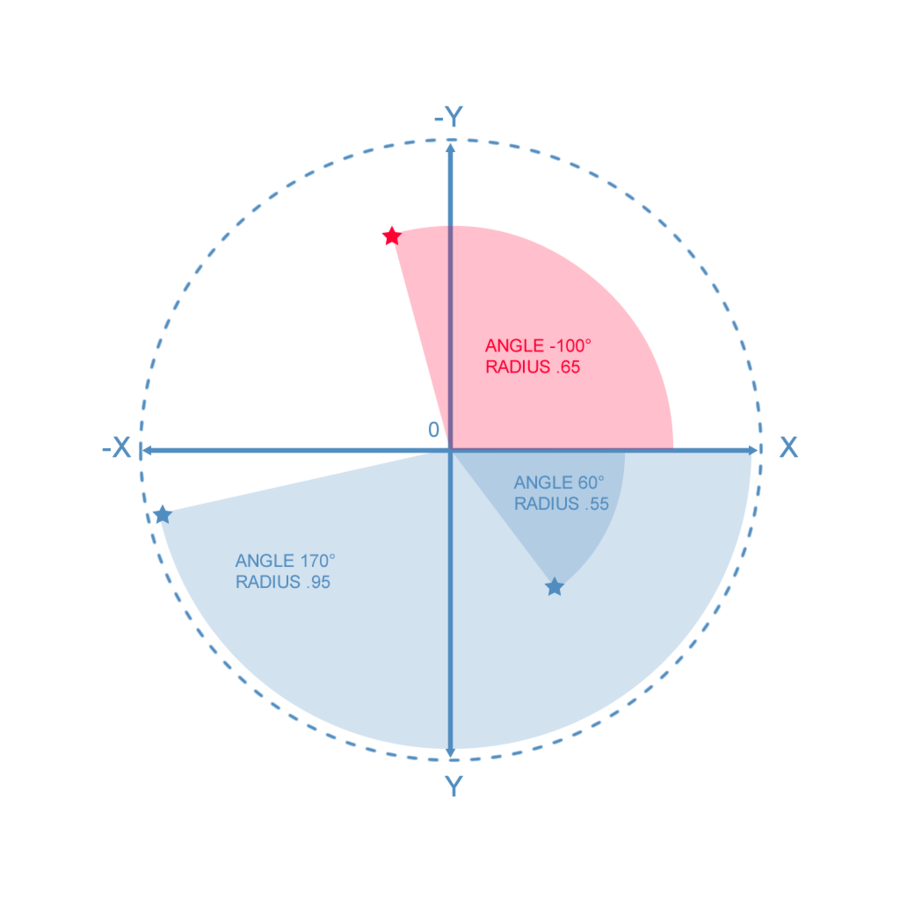
cylindrical space
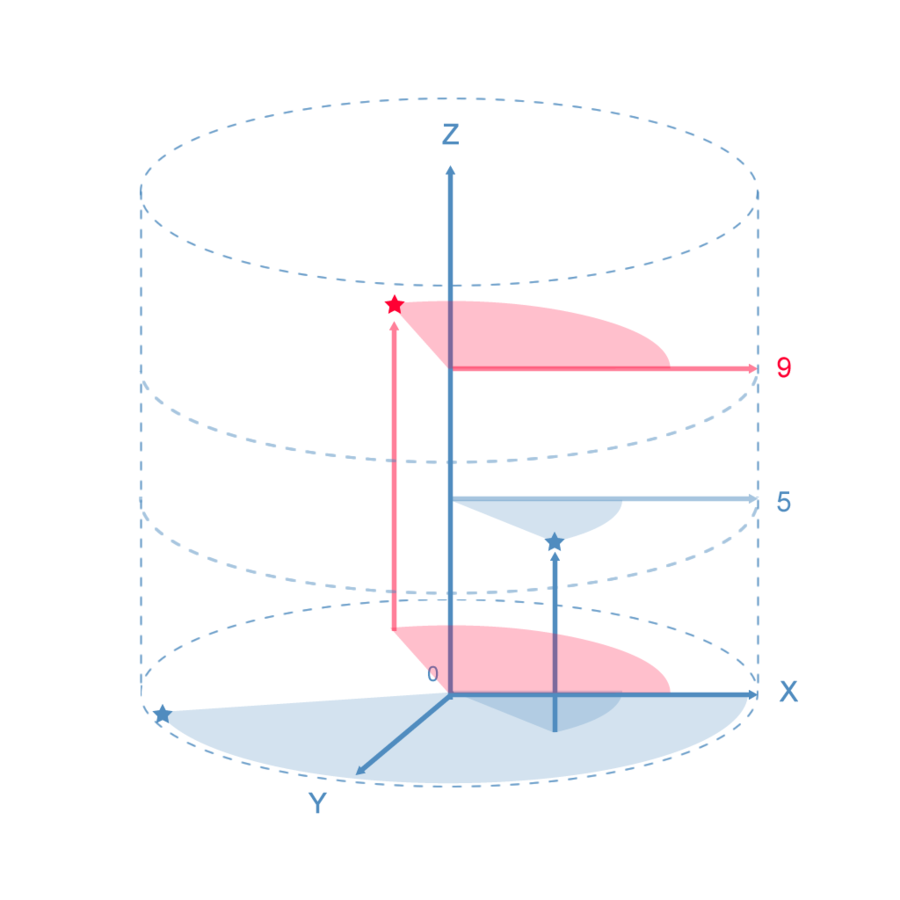
spherical space

cartesian space 3D
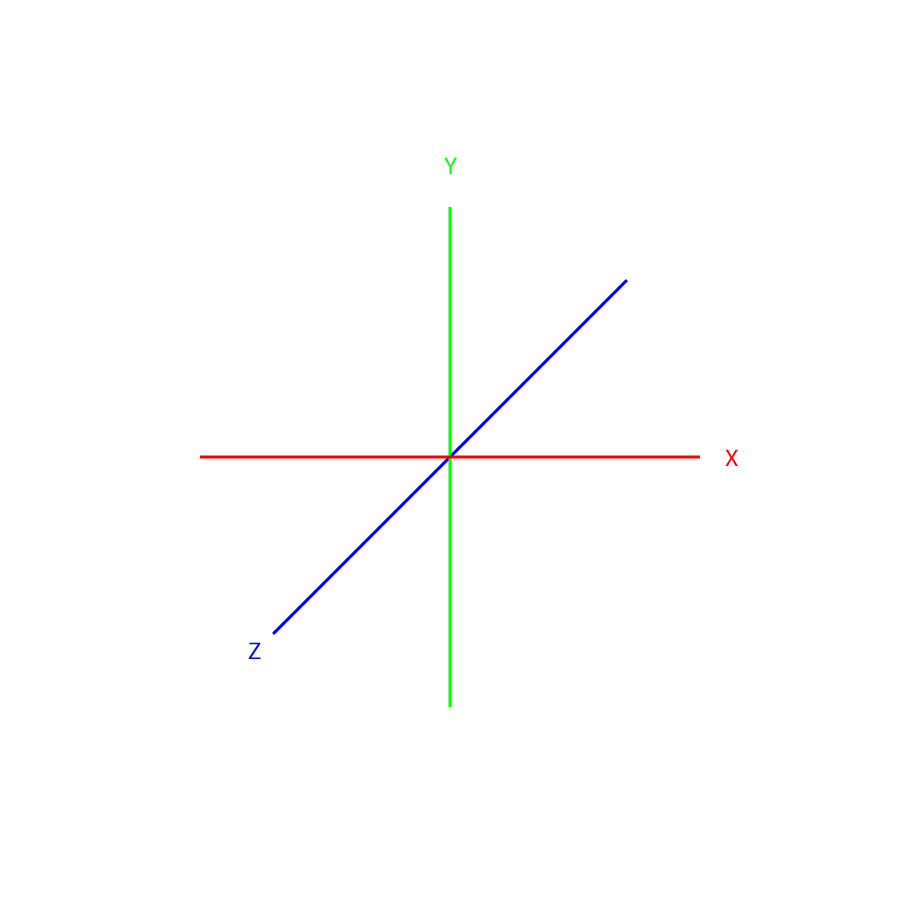
color
RGB color space

HSL cylindrical space
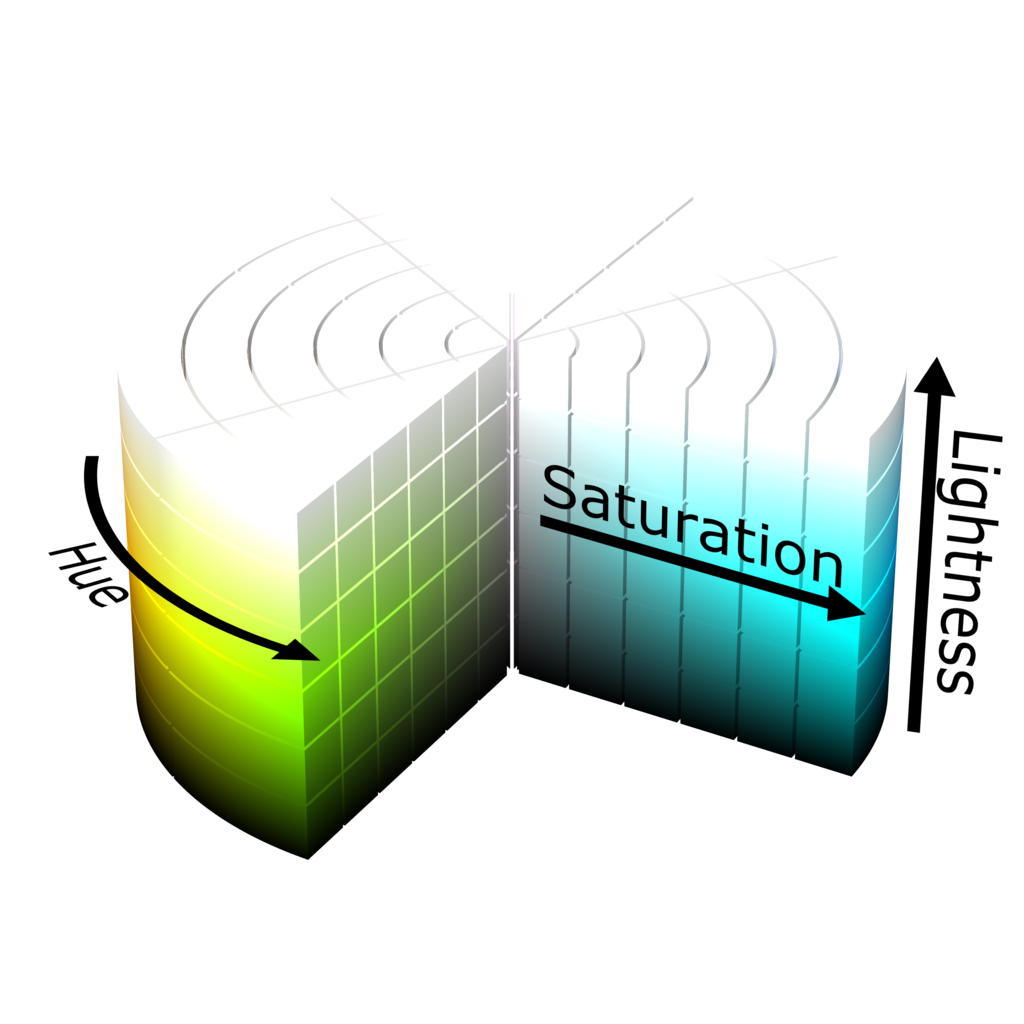
HSL spherical space

sound
mono sound wave (2D)

stereo sound wave (3D)

higher dimensions
4D space

point in a 4D space

line in a 4D space

cube in a 4D space

RGBA (4D) color space

5.1 stereo sound system (N-D)

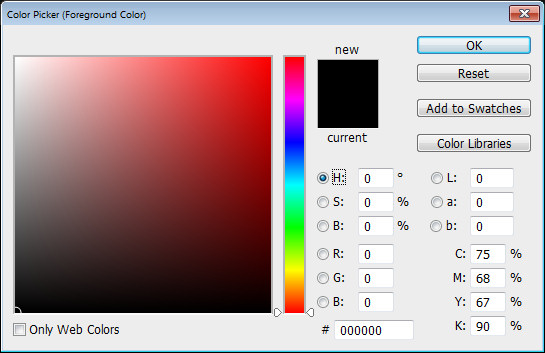
a color palette is a 2D projection of a 3D/4D object
here, the spectrum represents the "missing data"

in a 2D projection of a 3D mesh, the depth data is lost
a depth buffer is used to represent the "missing data"

a t-SNE reduces data dimensionality
and creates similarity clusters
keep the parameter count as low as possible
other spaces
physical/tangible space
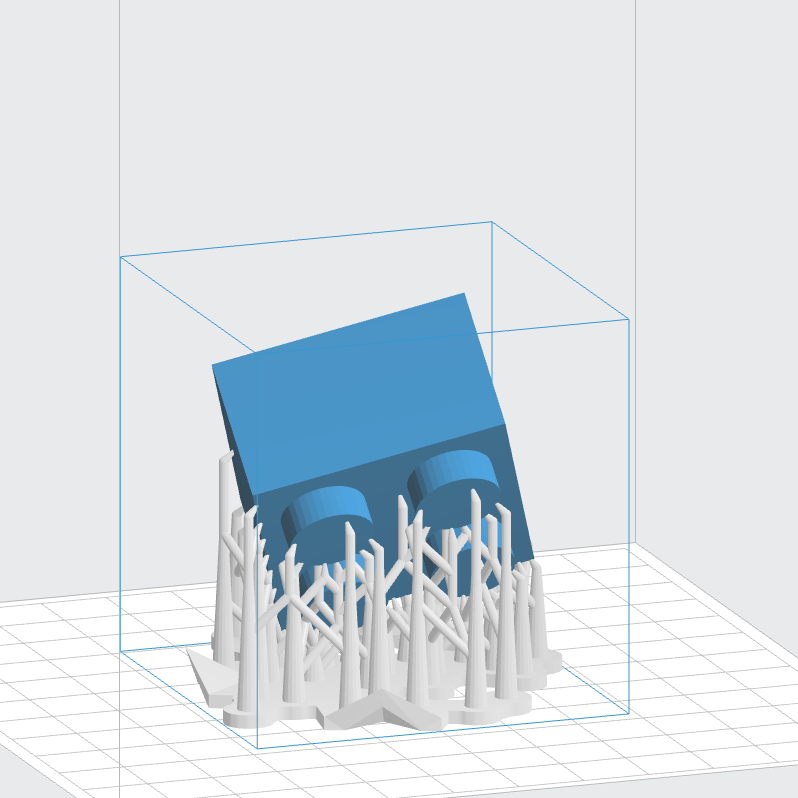
spatialized sound
notes on blindnessnon euclidean space

hyperbolic space
Model of Hyperbolic Space.by Daina Taimina, 2011.
3. process
data space designtranslation / rotation / scale
the basic transformations, let usperform distributions in space
grid / frame
//regular grid with 50px cells
var cellSize = 50, i, j;
for( i = 0; i <= w; i += cellSize ){
for( j = 0; j <= h; j += cellSize ){
//grid cell indices
var cell_x = Math.round( i / cellSize );
var cell_y = Math.round( j / cellSize );
//grid
circle( i, j, 2 );
//sub-grid
if( ( cell_x >= 20 && cell_x <= 26 )
&& ( cell_y >= 8 && cell_y <= 20 ) ){
circle( i, j, 5 );
}
//frame
//horizontal lines
if( ( cell_x >= 16 && cell_x <= 30 )
&& ( cell_y == 3 || cell_y == 12 ) ){
circle( i, j, 10 );
}
//verical lines
if( ( cell_x == 16 || cell_x == 30 )
&& ( cell_y >= 3 && cell_y <= 12 ) ){
circle( i, j, 10 );
}
}
}circle / disc
//points count
var count = 24;
//angle step ( angle between 2 points on the circle )
var step = Math.PI * 2 / count;
//circle radius
var radius = h / 3;
//circle distribution
for( var angle = 0; angle < Math.PI * 2; angle += step ){
//computes the X / Y position
var x = Math.cos( angle ) * radius;
var y = Math.sin( angle ) * radius;
//draw this point
circle( x, y, 10 );
}
//radial distribution
var radialSegments = 15;
for( angle = 0; angle < Math.PI * 2; angle += step * 2 ){
for( var i = 0; i < radialSegments; i++ ){
var r = i * ( radius / radialSegments);
x = Math.cos( angle ) * r;
y = Math.sin( angle ) * r;
circle( x, y, 3 );
}
}
//spiral distribution
var turns = 3;
for( angle = 0; angle < Math.PI * 2 * turns; angle += step / 4 ){
r = radius * ( angle / ( Math.PI * 2 * turns ) );
console.log( i / ( Math.PI * 2 * turns ) );
x = Math.cos( angle ) * r;
y = Math.sin( angle ) * r;
circle( x, y, 1 );
}triangles
function reset(){
//measures of an equalateral triangle
var sides = 3;
var L = 2 * Math.sin( Math.PI / sides ); //side length
var A = L / ( 2 * Math.tan( Math.PI / sides ) ); //apothem
var H = ( 1 + A ); //radius + apothem
var size = 50;
L *= size;
H *= size;
var mx = 2 * Math.ceil( w / L );
var my = Math.ceil( h / H );
for( var i = 0; i < w; i+= mx ){
for( var j = 0; j <= h; j+= my ){
//cell indices
var cx = Math.round( i/mx );
var cy = Math.round( j/my );
//coordinates
var x = ( cx ) * L / 2;
var y = ( cy ) * H;
//triangular pattern
var mody = cy % 2;
if(( cx % 2 == 1 && cy % 2 == 0 )
|| ( cx % 2 == 0 && cy % 2 == 1 )){
circle(x, y, 5);
} else {
circle(x, y, 1);
}
//hexagonal pattern
var modx = cx % 6;
if(( mody == 0 && ( modx == 1 || modx == 3 ) )
|| ( mody == 1 && ( modx == 0 || modx == 4 ) ) ){
circle( x, y, 10 );
}
}
}
}fields
assign a value at givenlocations in space
var HPI = Math.PI / 2;
function angle(a,b){
var dx = a[0] - b[0];
var dy = a[1] - b[1];
return Math.atan2( dy, dx );
}
//method to draw an arrow
function drawArrow( p0, p1, size ){
var a = angle( p0, p1 );
ctx.beginPath();
ctx.moveTo(p0[0], p0[1]);
ctx.lineTo(p0[0] + Math.cos( a + HPI ) * size, p0[1] + Math.sin( a + HPI ) * size);
ctx.lineTo(p1[0], p1[1]);
ctx.lineTo(p0[0] + Math.cos( a - HPI ) * size, p0[1] + Math.sin( a - HPI ) * size);
ctx.fill();
}
//this is the value at a given X/Y location
function getValue( x, y ){
return Math.cos( x ) * Math.sin( y ) + Date.now() * 0.001;
}
function reset() {
var cellSize = 50;
var points = [];
var values = [];
//regular grid with 50px cells that covers the screen
for( var i = 0; i <= w; i += cellSize ){
for( var j = 0; j <= h; j += cellSize ){
points.push( [i,j] );
values.push( getValue( i, j ) );
}
}
//draws an arrow at each point (lattice)
points.forEach( function( p, id ){
//direction
var p1 = [
p[0] + Math.cos( values[id] ) * cellSize * .75,
p[1] + Math.sin( values[id] ) * cellSize * .75
];
//draw arrow
drawArrow( p, p1, cellSize * .2 );
});
}point symmetry
function rotate(p, lattice, angle){
var a = getAngle(lattice, p) + angle;
var d = getDistance(lattice, p);
var pp = new Point();
pp.x = lattice.x + Math.cos(a) * d;
pp.y = lattice.y + Math.sin(a) * d;
return pp;
}
//random walk:
// make a point move randomly X times on X / Y
// store each position in an array
var count = 64;
var steplength = 20;
var p = new Point();
var points = [];
for( var i = 0; i < count; i++ ){
p.x += steplength;
p.y += ( Math.random() - .5 ) * steplength;
//p.clone() return a copy of the point
points.push( p.clone() );
}
//performs a series of rotations around a point (center)
var center = new Point();
var rotations = 64;
var angleStep = Math.PI * 2 / rotations;
var tmp = new Point();
for( i = 0; i < rotations; i++ ){
var rotated = [];
points.forEach( function( p ){
if( i == 0 )circle(p.x,p.y, 2 );
tmp = rotate( p, center, angleStep * i );
rotated.push( tmp );
});
renderLine( rotated );
}projection
function project(p, a, b, asSegment) {
var dx = b.x - a.x;
var dy = b.y - a.y;
if (asSegment && dx == 0 && dy == 0) return a;
var t = ( ( p.x - a.x ) * dx + ( p.y - a.y ) * dy) / ( dx * dx + dy * dy );
if (asSegment && t < 0) return a;
if (asSegment && t > 1) return b;
return new Point(a.x + t * dx, a.y + t * dy);
}
var steplength = 30;
var p = new Point(0, h/2);
var points = [];
for( var i = 0; i <= w; i+=steplength ){
p.x = i;
p.y += ( Math.random() - .5 ) * steplength;
circle( p.x, p.y, 2 );
points.push( p.clone() );
}
renderLine( points );
//performs a series of projections onto an axis
// define by the start & end points
var start = new Point( 0, h - h / 4 );
var end = new Point( w, h - h / 4 );
points.forEach( function( p ){
var tmp = project( p, start, end );
line(p,tmp);
});
line( start, end );
//performs a series of projections onto an axis
// define by the start & end points
start = new Point( 0, 0 );
end = new Point( w, h );
points.forEach( function( p ){
var tmp = project( p, start, end );
line(p,tmp);
});
line( start, end );reflection
function reflect(p, a, b) {
var pp = project(p, a, b);
return new Point(p.x + ( pp.x - p.x ) * 2, p.y + ( pp.y - p.y ) * 2);
}
var radius = h/3;
var step = Math.PI * 2 / 64;
var center = new Point(w/2, h/2);
var points = [];
//distributes points on a quarter of a circle
for (var i = 0; i < Math.PI / 2 + step; i += step ) {
var p = new Point(
center.x + Math.cos( i ) * radius,
center.y + Math.sin( i ) * radius
);
points.push(p.clone());
}
//vertical symmetry
var start = new Point( 0, h/2 );
var end = new Point( w, h/2 );
points.forEach(function (p) {
var tmp = reflect( p, start, end);
line(p, tmp);
});
//horizontal symmetry
start = new Point( w/2, 0 );
end = new Point( w/2, h );
points.forEach(function (p) {
var tmp = reflect( p, start, end);
line(p, tmp);
});
//diagonal symmetry
start = new Point( w/2-radius, h/2+radius );
end = new Point( w/2+radius, h/2-radius );
points.forEach(function (p) {
var tmp = reflect( p, start, end);
line(p, tmp);
});extension to 3D space
just add a third dimensiongrid, frame => box, extruded frame
circle, disc => torus, sphere
triangles => regular polyhedron
fields are N-Dimensional
rule-based systems
grammar
series of rules that defines allvalid sentences of a language
formal grammar
a formal grammar is based on production rules, takesan axiom as an input and determines if it is valid
the next illustration is a "finite state machine"
it describes all the production rules relationships

instead of writing a dictionary of all the valid axioms,
we can use this FSM to ckeck if an axiom is valid

L-system
variation on formal grammarused to model plants' growth
variables : A B
axiom : A
rules : (A → AB), (B → A)n=0: A start (axiom/initiator)
/ \
n=1: A B (A→AB)
/| \
n=2: A B A (A→AB), (B→A)
/| | |\
n=3: A B A A B (A→AB), (B→A), (A→AB)
/| | |\ |\ \
n=4: A B A A B A B A (A→AB), (B→A), (A→AB), (A→AB), (B→A)iteration, recursion, trees & graph
iteration
var RAD = Math.PI / 180;
//stores some vairables
var points = [];
var angles = [];
var speeds = [];
for( var i = 0; i < 20; i++ ){
//point position
points.push( new Point(w/2, h/2) );
//starting angle
angles.push( Math.random() * Math.PI * 2 );
//rotation speed
speeds.push( 5 + Math.random() * 25 );
}
ctx.beginPath();
//iterate 2000 times
for( i = 0; i < 2000; i++ ){
//iterate over all points
points.forEach( function( p, id ){
//move the pen to the current position
ctx.moveTo( p.x, p.y );
//updates angle
angles[id] += ( Math.random() - .5 ) * RAD * speeds[id];
//updates the point's position
p.x += Math.sin( angles[id] );
p.y += Math.cos( angles[id] );
//draws line to new position
ctx.lineTo( p.x, p.y );
});
}
ctx.stroke();recursion
function draw(p0, p1, p2) {
ctx.beginPath();
ctx.moveTo(p0.x, p0.y);
ctx.lineTo(p1.x, p1.y);
ctx.lineTo(p2.x, p2.y);
ctx.closePath();
ctx.stroke();
}
function sierpinski(p0, p1, p2, count ) {
//break condition
if(count <= 0) {
//render
draw(p0, p1, p2);
}else{
//decrease the counter
count--;
//find the edges' centers
var a = [ ( p0.x + p1.x ) / 2, (p0.y + p1.y) / 2 ];
var b = [ ( p1.x + p2.x ) / 2, (p1.y + p2.y) / 2 ];
var c = [ ( p2.x + p0.x ) / 2, (p2.y + p0.y) / 2 ];
//calls the method on the new triangles
sierpinski( p0, a, c, count );
sierpinski( p1, b, a, count );
sierpinski( p2, c, b, count );
}
}
sierpinski( points[0], points[1], points[2], 6 );
recursive tree
function branch(length, angle) {
line(0, 0, 0, -length);
ctx.translate(0, -length);
if (length > 2) {
length *= 0.65;
ctx.save();
ctx.rotate(angle);
branch(length, angle);
ctx.restore();
ctx.save();
ctx.rotate(-angle);
branch(length, angle);
ctx.restore();
}
}
function line(x0, y0, x1, y1) {
ctx.beginPath();
ctx.moveTo(x0, y0);
ctx.lineTo(x1, y1);
ctx.stroke();
}
ctx.translate(w/2,h/2 + 300);
branch( 200, Math.PI / 180 * 30 );graph
var Vertex = function( data ){ /*store the data*/ }
var Edge = function( v0, v1 ){
this.v0 = v0;
this.v1 = v1;
}
var Graph = function( vertices, edges ){
this.vertices = vertices;
this.edges = edges;
}
//create two vertices
var A = new Vertex( data );
var B = new Vertex( data );
//create an edge to bind the two vertices
var E = new Edge( A, B );
//create a graph
var graph = new Graph( [ A, B ], [ E ] );this is the essence of procedural generation:
describing the rules of productionrather than the objects themselves
further considerations
random & pseudo-random
a random() methods create sequences that are - by definition - hard to reproduce. prefer a Pseudo Random Number Generator (PRNG) that produces seemingly random series of numbersrandom, noise, turbulence
random values are often "too random". use a noise to soften the variations. a turbulence is an accumulation of noises sampled at various scales (octaves)
function pseudoRandom(x, y) {
return ( ( Math.sin( x * 12.9898 + y * 78.233) ) * 43758.5453123 ) % 1;
}
function noise(x, y) {
//gets the integer part
var ix = parseInt(x);
var iy = parseInt(y);
// 2D cell corners
var a = pseudoRandom(ix,iy);
var b = pseudoRandom(ix+1, iy);
var c = pseudoRandom(ix, iy+1);
var d = pseudoRandom(ix+1, iy+1);
//gets the fractional part
var fx = (x % 1);
var fy = (y % 1);
var ux = fx * fx * (3.0 - 2.0 * fx);
var uy = fy * fy * (3.0 - 2.0 * fy);
//interpolate the 4 noises with fractional parts
return (a * (1-ux) + b * ux) + (c - a) * uy * (1.0 - ux) + (d - b) * ux * uy;
}
function FBM( x, y ){
var OCTAVES = 6;
var value = 0;
var amplitude = .5;
for (var i = 0; i < OCTAVES; i++) {
value += amplitude * noise(x,y);
x *= 2.;
y *= 2.;
amplitude *= .5;
}
return value;
}trails & traces
preserve previously drawn framecheap way of adding complexity
//clear half the screen
ctx.clearRect(0,0,w/2,h);
//draw a translucent rect on top of the other half
ctx.fillStyle = "#FFF";
ctx.globalAlpha = .05;
ctx.fillRect(w/2,0,w/2,h);emergent pattern
var morph = Date.now() * 0.0005;
var time = Date.now() * 0.001;
//points count
var total = 16;
var count = Math.min( Math.max( 1, Math.round( ( .5 + Math.cos( morph ) ) * total ) ), total );
var step = Math.PI / total;
//circle radius
var radius = h / 3;
ctx.globalAlpha = .25;
circle( 0,0, radius );
//circle distribution
for( var angle = 0; angle < count * step; angle += step ){
//computes the X / Y position
var x = Math.cos( angle ) * radius * ( Math.cos( angle + time ));
var y = Math.sin( angle ) * radius * ( Math.cos( angle + time ));
//draw this point
ctx.globalAlpha = 1;
circle( x, y, 3 );
//draw the line
ctx.globalAlpha = .25;
line( Math.cos( angle ) * radius, Math.sin( angle ) * radius,
Math.cos( angle ) * -radius, Math.sin( angle ) * -radius );
}
emergent behaviour
//tests proximity to all other boids
boids.forEach(function (other) {
//if it's the same object, bail out
if (boid == other)return;
//compute position delta
var dx = boid.x - other.x;
var dy = boid.y - other.y;
//compute boids' distance
var dist = Math.sqrt(dx * dx + dy * dy);
if (dist < boid.separation) {
separation.x += dx;
separation.y += dy;
}else{
if (dist < boid.cohesion) {
cohesion.x += dx;
cohesion.y += dy;
}
if (dist < boid.alignment) {
alignment.x += other.speed.x;
alignment.y += other.speed.y;
}
}
});
//computes the total acceleration
if( separation.length() > 0 ){
separation.normalize().multiplyScalar( separate );
boid.acceleration.add( separation );
}
if( cohesion.length() > 0 ){
cohesion.normalize().multiplyScalar( cohede );
boid.acceleration.sub( cohesion );
}
if( alignment.length() > 0 ){
alignment.normalize().multiplyScalar( align );
boid.acceleration.sub( alignment );
}parametrisation & expressiveness
drawing an anthyper-realistic 3D render
ANT (Atta laevigata) by javier porcel


depending on the context those are equally valid representations of an ant. use relevant parameters
graphic tools
processing
openframeworks
context free grammar
recursively applies production rules and stops when the axiom only contains terminal symbols (primitives)structuresynth
#define _col0 #F00
#define _col1 #FF0
#define _inc 0.1
40 * { y 0.1 ry 9 rz -2 s 1.01 1.01 1.01 color _col0 }column
rule column w 0.5{
{ y 0.5 ry 18 blend _col1 _inc }box
}
rule column w 0.2{
{ x -0.25 z -0.25 y 0.5 s 0.8 blend _col1 _inc } box
}
rule column w 0.2{
20 * { rx 1 ry 1.5 rz 3 s 0.75 0.95 1.10 blend _col1 _inc }box
}context free art (2d)
eisenscript demo (3D)
magicavoxel
shadertoy
fragment shader black magichoudini
excellent series of tutorialsblender
functional scripting examplemeshlab
convolutional neural networks &
generative advesrsarial networks
it's the future but for now it's mostlyacademic papers with funny names:
Learning a Probabilistic Latent Space of Object Shapes via 3D Generative-Adversarial Modeling
Unsupervised Representation Learning with Deep Convolutional Generative Adversarial Networks
Evolution Strategies as a Scalable Alternative to Reinforcement Learning
generative design studios
universal everythingonformative
variable.io
field.io
waltz binaire
no computer
AM-CB
twitter accounts
tylhobbs MacTuitui P_Malin FogleBird pissang1 mystaticself M_PF Flexi23 JoanieLemercier inconvergent WilliamChyr mariuswatz xorxor_hu hyper_glu AdrienMClaireB laserberg AtticusBones _kzr aiekick wearekuva ExUtumno generateme_blog genekogan wearenocomputer _Nick_Taylor cupe_cupe eddietree albertomoss ariweinkle hughskennedy TatumCreative akirodic RavenKwok patriciogv cornusammonis mflux legomushroom roland_huf prideout p01 liabru kenji_special mattdesl lennyjpg dbtwr gordonnl kyndinfo edankwan evanbbb? novastructura thespite moebio alteredq marcinignac BlurSpline philogb wblut toxi RezaAli soulwire oosmoxiecode felixturner marpi_ subblue grgrdvrt quasimondo flight404 sougwen kcimc
useful methods
linear interpolation
function lerp ( t, a, b ){
return a * (1-t) + b * t;
}normalisation
function norm( t, a, b ){
return ( t - a ) / ( b - a );
}mapping
function map( t, a0, b0, a1, b1 ){
return lerp( norm( t, a0, b0 ), a1, b1 );
}distance
function distance( p0, p1 ){
var dx = p0.x - p1.x;
var dy = p0.y - p1.y;
return sqrt( dx * dx + dy * dy );
}angle
function angle( p0, p1 ){
return atan2( p1.y - p0.y, p1.x - p0.x );
}polar coordinates
x = cos( angle ) * radius;
y = sin( angle ) * radius;cylindrical coordinates
x = cos( angle ) * radius;
y = height value;
z = sin( angle ) * radius;
spherical coordinates
var theta = 0 > ? > PI * 2;
var phi = -PI > ? > PI;
x = sin(theta) * cos( phi ) * radius;
y = sin(theta ) * sin( phi ) * radius;
z = cos( theta ) * radius;project
function project(p, a, b, asSegment) {
var dx = b.x - a.x;
var dy = b.y - a.y;
if (asSegment && dx == 0 && dy == 0) {
return a;
}
var t = ( ( p.x - a.x ) * dx + ( p.y - a.y ) * dy) / ( dx * dx + dy * dy );
if (asSegment && t < 0) return a;
if (asSegment && t > 1) return b;
return new Point(a.x + t * dx, a.y + t * dy);
}reflect
function reflect(p, a, b) {
var pp = project(p, a, b);
return new Point(p.x + ( pp.x - p.x ) * 2, p.y + ( pp.y - p.y ) * 2);
}